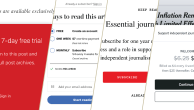About this Survey
Results for the main survey on Media Consumption are based on telephone interviews conducted under the direction of Princeton Survey Research Associates among a nationwide sample of 3,002 adults, 18 years of age or older, during the period April 24-May 11, 1998. For results based on the total sample, one can say with 95% confidence that the error attributable to sampling and other random effects is plus or minus 2.5 percentage points. For results based on either Form A (N=1,499) or Form B (N=1,503), the sampling error is plus or minus 3 percentage points.
Results for the Believability Study are based on telephone interviews conducted under the direction of Princeton Survey Research Associates among a nationwide sample of 981 adults, 18 years of age or older, during the period May 7-13, 1998. For results based on the total sample, one can say with 95% confidence that the error attributable to sampling and other random effects is plus or minus 3.5 percentage points.
In addition to sampling error, one should bear in mind that question wording and practical difficulties in conducting surveys can introduce error or bias into the findings of opinion polls.
Survey Methodology in Detail
The samples for the two surveys are random digit samples of telephone numbers selected from telephone exchanges in the continental United States. The random digit aspect of the samples is used to avoid “listing” bias and provides representation of both listed and unlisted numbers (including not-yet- listed). The design of the samples ensures this representation by random generation of the last two digits of telephone numbers selected on the basis of their area code, telephone exchange, and bank number.
The telephone exchanges were selected with probabilities proportional to their size. The first eight digits of the sampled telephone numbers (area code, telephone exchange, bank number) were selected to be proportionally stratified by county and by telephone exchange within county. That is, the number of telephone numbers randomly sampled from within a given county is proportional to that county’s share of telephone numbers in the U.S. Only working banks of telephone numbers are selected. A working bank is defined as 100 contiguous telephone numbers containing three or more residential listings.
Each sample was released for interviewing in replicates. Using replicates to control the release of sample to the field ensures that the complete call procedures are followed for the entire sample. The use of replicates also insures that the regional distribution of numbers called is appropriate. Again, this works to increase the representativeness of the sample.
For the Media Consumption survey, at least 10 attempts were made to complete an interview at every sampled telephone number; for the Believability Study, at least seven attempts were made. The calls were staggered over times of day and days of the week to maximize the chances of making a contact with a potential respondent. All interview breakoffs and refusals were re-contacted at least once in order to attempt to convert them to completed interviews. In each contacted household, interviewers asked to speak with the “youngest male 18 or older who is at home”. If there is no eligible man at home, interviewers asked to speak with “the oldest woman 18 or older who lives in the household”. This systematic respondent selection technique has been shown empirically to produce samples that closely mirror the population in terms of age and gender.
Non-response in telephone interview surveys produces some known biases in survey-derived estimates because participation tends to vary for different subgroups of the population, and these subgroups are likely to vary also on questions of substantive interest. In order to compensate for these known biases, the sample data are weighted in analysis.
The demographic weighting parameters are derived from a special analysis of the most recently available Census Bureau’s Current Population Survey (March 1996). This analysis produced population parameters for the demographic characteristics of households with adults 18 or older, which are then compared with the sample characteristics to construct sample weights. The analysis only included households in the continental United States that contain a telephone.
The weights are derived using an iterative technique that simultaneously balances the distributions of all weighting parameters.
About the News Typology
The six-group news typology was developed by classifying people based on how regularly they use 17 varied news sources. In the survey, respondents were asked how often they watch, read or listen to various types of television and radio programs and news publications. Specifically, the news sources used in developing the typology were: nightly network news, local television news, CNN, C-SPAN, National Public Radio, television news magazine, the NewsHour with Jim Lehrer, television shows such as Hard Copy or Inside Edition, morning shows like the Today Show and Good Morning America, CNBC, the FOX News Cable channel, MSNBC, the Weather Channel, ESPN Sports News, Entertainment Tonight, the National Enquirer, and personality magazines such as People (see Q.16 through Q.18 of the Media Consumption survey).
The typology was developed through a two-step statistical procedure involving factor analysis and cluster analysis. Factor analysis was used to identify groups of similar news sources and, in turn, for selection of the 17 news sources listed above. Subsequently, cluster analysis was used to classify individuals into groups of people who are similar in their use of these news sources. Several different cluster solutions were evaluated using three criteria: the average within-group variance in terms of frequency of use of the news sources, compared to the total sample variance; the between-group variances, based on the variance of the means across groups in terms of use of the news sources; and the size, demographic composition, and media-orientations (based on independent measures that were not used to create the clusters) of the various groups. On the basis of these evaluations, the six-group cluster was chosen.




